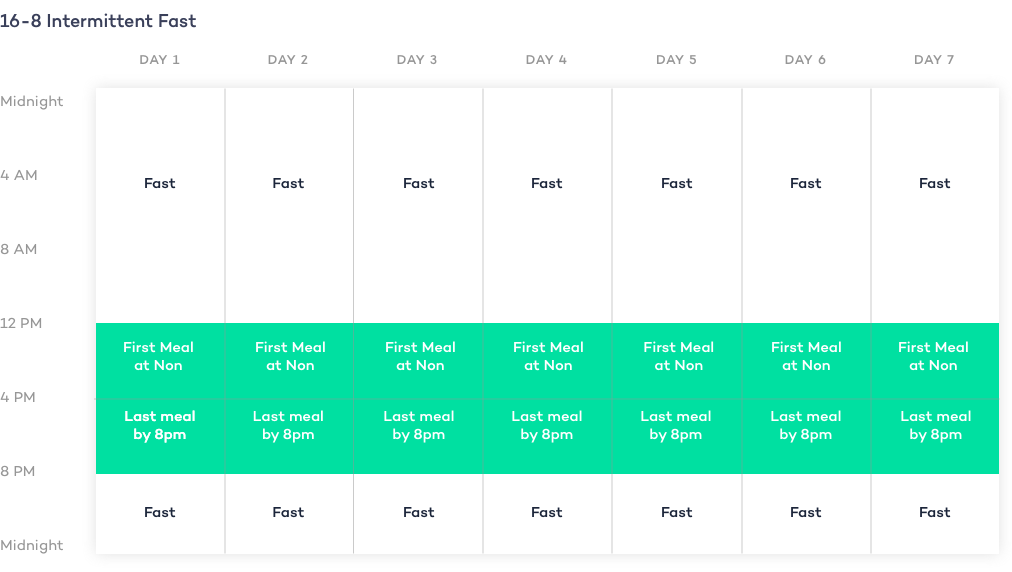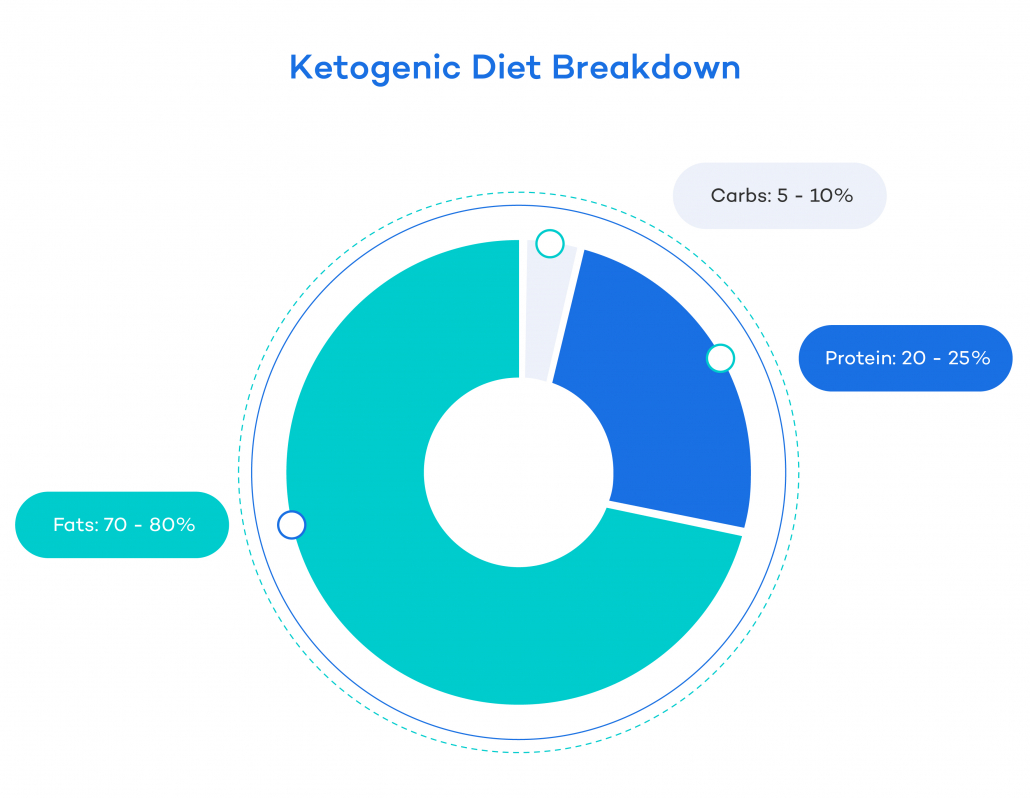We include products in articles we think are useful for our readers. If you buy products or services through links on our website, we may earn a small commission.
Intermittent Fasting and Keto: How To, Benefits, and Meal Plan

Table of Contents
Intermittent fasting and keto are two of the most popular approaches to achieving health and wellness through our diet.
So it’s only natural that people are asking if intermittent fasting and keto can, or should be practiced together?
The short answer is, yes.
Both intermittent fasting (IF) and keto are inspired by ancestral ways of eating. From an ancestral (evolutionary) perspective, our bodies are evolved to thrive on a fast-and-feast cycle. And recent research into ancient human eating habits has revealed that these “feasts” were centered on fatty animal meats.2
In this article, we’ll explore the question of combining intermittent fasting with keto, while looking at the science-backed benefits. We’ll also provide a 7 day IF and keto meal plan.
Intermittent Fasting and Keto in Human Evolution
For nearly two million years our ancestors lived in a world teeming with large prey (megafauna). 3
When a hunt was successful our ancestors feasted, and when the hunt failed, they fasted.
Over eons of human evolution, our ancestors whose brains and bodies functioned the best in fasted states were also the best at hunting and gathering food–and ultimately at surviving and reproducing. This means the genes that shaped their metabolism have been passed along to us.
We see evidence of our bodies’ adaptation to cycles of fasting and feasting in the way we:
- easily store fat: Our fuel supply in-between successful hunts
- easily go into ketosis: How we convert stored fat and the fat we eat, into fuel during times when carbohydrates and calories are scarce. [3]
- have reduced cognitive ability (i.e. we’re dumber) when not fasting, because our brains are hard-wired to function optimally during times of food scarcity. [4]
What is Intermittent Fasting?
Intermittent fasting is a way of recreating our ancestral eating patterns in modern life.
This means cycling between daily periods of not eating, and windows for eating.
There are many methods for practicing IF that you can learn about here.
When done properly IF has been shown to 2 3 4:
- regulate blood glucose
- control blood lipids including cholesterol and triglycerides
- reduce the risk of coronary disease
- manage body weight
- help you gain (or maintain) lean muscle mass
- stimulate human growth hormones
- activate stemcell production
- reduce the risk of cancer, and more
Here’s an example of a popular 16:8 fasting method:

What is a Ketogenic Diet?
A ketogenic (keto) diet means eating high-fat, moderate-protein, and low-to-no carbohydrates.
By cutting carbs and getting most of your calories from fat, our bodies switch from relying on carbohydrates for fuel, to converting the fat we eat, and the fat we store on our bodies, into molecules called ketones that fuel our cells.
When the levels of ketones in our blood get elevated, we enter the metabolic state called ketosis–the root of the term “keto diet”.
The calorie breakdown of a typical ketogenic diet looks like:
- 70-80% of calories from fat
- 15-30% calories from protein
- 0-10% calories from carbohydrates
Most ketones pack more energy per unit than carbs. They can also fuel the vast majority of your cells. For the few other types of cells that need glucose, your body will synthesize it from protein. This is a natural process called gluconeogenesis.

Benefits of Keto Diet
With its soaring popularity, keto has received a lot of attention from researchers. Though the science is still coming out, clinical studies have already found that keto can provide numerous benefits including:
- Improved blood lipid levels.
- Improved insulin sensitivity.
- Reductions in the severity of type 2 diabetes, fatty liver disease
- Reduces and reverse symptoms of PCOS
- Treatment for numerous types of cancer
- Reduces and slows the progression of neurological disorders like epilepsy, Alzheimer’s and Parkinson’s disease.
- Significant weight loss
- Make meals more satiating, reducing cravings for processed and high-carb foods
- Regulates inflammation and increases immunity
- Helps your body absorb fat-soluble vitamins (K, D, E, etc).
- Protects the glycocalyx –the membrane that covers the surface of every cell, responsible for overall health, and is easily damaged by sugar intake.
Benefits of Combining Intermittent Fasting and Keto
As you can see from above, intermittent fasting and keto share a number of benefits like improved fat burning, better cellular repair, improved insulin sensitivity, and lower risk of disease.
Now let’s explore some of the ways that combining IF and keto may increase these benefits and offers others.
May Smooth Your Transition into Ketosis
Keto is about switching your body from using carbohydrates for energy, to turning fat into ketones. The typical way to do this is by cutting carbs and increasing fat intake in your diet. For many people this transition can take some time and it comes with a number of unpleasant side effects known as “keto flu.”
IF speeds up ketosis and smooths the transition. When you fast, your insulin levels drop, causing your body to use its stored carbs (glycogen). Once these are depleted your body begins using fat for fuel. 1 2
Think of fasting as a way to jump start ketosis.
May Increase Weight Loss
Both intermittent fasting and keto are clinically proven to promote weight loss. When skillfully combined, the weight-reducing factors in each are strengthened: IF promotes thermogenesis, while keto tells your body to metabolize stored fat.
Sustained Fuel Source Between Meals
Fat digests much more slowly than carbohydrates, and ketones pack more energy per unit than glucose.2
When you’re on a well-formulated high-fat keto diet, your blood sugar rarely drops to a point where you get hunger cravings and doesn’t spike to a point where you lose focus.
Ketones are also effective at suppressing ghrelin, the hormone that makes you feel hungry.
Both intermittent fasting and keto diets have been shown to reduce hunger.1 And ketogenic meals are more satiating, leading to a reduction in food cravings. This in turn supports an intermittent fasting schedule that calls for extended periods without eating.
Reduce Hypoglycemic Stress
Longer periods of intermittent fasting can lead to consistently depleted blood sugar–especially when you’re body is not keto-adapted. These periods can cause hypoglycemic stress that triggers the body to release stress hormones like GnRH, glucagon, human growth hormone, epinephrine, and cortisol.
The presence of these stress hormones can disrupt female reproduction. GnRH in particular regulates the release of luteinizing hormone (LH) and the follicle-stimulating hormone (FSH)–two important reproductive hormones.
Disruption of these hormones can result in issues like irregular periods, amenorrhea, infertility, reduced ovary size, and decreased bone density. [19] [20] [21]
The good news is that combining intermittent fasting and keto can reduce hypoglycemic stress and related hormone imbalances.
When your body is keto-adapted, you are not dependent on carbohydrates, and your blood sugar remains far more stable.
Keto Can Fuel and Protect Fasting-Stimulated Stem Cells
Studies show that intermittent fasting can increase the production of stem cells in the intestines, muscles, and brain. At the same time, IF preserves the ability for stem cells to regenerate independently in the long term. [4]
Yet ending a fast with sugary processed foods can lead to precancerous lesions and increased cancerous activity–especially in the intestines and liver.
Combining intermittent fasting with a high-fat, low-carb keto diet fertilizes the fresh crop of new cells with energy-packed ketones, while protecting them from the damage wrought by carbs and insulin.
Increased Cellular Renewal
Intermittent fasting can trigger a process of cellular “spring cleaning,” called autophagy. Old cells are metabolized, and new cells are born (see above), keeping tissues healthy.
When you combine IF with a keto diet that cuts out carbs, you’re expediting the removal of cells damaged by the bonding of sugar molecules in a process called glycation.
Enhanced Anti-Cancer Factors
Studies on mice show that fasting can result in significant reductions in the incidence of lymphomas and tumors. [32] The anti-cancer factor is the decrease in glucose and insulin.
A keto diet virtually eliminates sugar. When you’re not eating sugar, your body isn’t producing insulin. In this way, intermittent fasting and keto combine to starve cancer cells that rely on sugar.
Intermittent Fasting and Keto Meal Plan
The following intermittent fasting and keto meal plan can be applied to essentially every method of intermittent fasting. This includes circadian rhythm fasting, and methods tailored specifically to women.
Each of the meals on this list is made with simple whole foods, is easy to prepare, and packed with healthy fats.
| Day 1 | Day 2 | Day 3 | Day 4 | Day 5 | Day 6 | Day 7 | |
| Lunch | Ribeye Steak and 2 eggs Asparagus sauteed in ghee | 3 scrambled eggs with creme fraiche & ½ avocado | Pork Belly 3 Eggs | 8 oz. Pork belly and 2 eggs with creme fraiche | Ground bison with butter and 2 eggs and ½ avocado | 4 scrambled eggs with tallow and creme fraiche | 8 oz Tri-tip roast |
| Dinner | 8 oz Tri-tip roast | 8 oz bison burger ½ cup blackberries w/ heavy cream | 12 oz. Beef short ribs | Ribeye steak with 2 tbls tallow and raw Oysters (3) | 6 oz. Bone marrow Zucchini in ghee | 8 oz wild salmon baked with creme fraiche | 6.5 oz Bison burger with 1.5 oz liver blended in |
Intermittent Fasting and Keto: The Takeaway
As ways of eating inspired by ancestral eating patterns, intermittent fasting and keto are two sides of the dietary coin.
Intermittent fasting speeds up metabolism, while keto switches your body into metabolizing its excess fat stores.
Intermittent fasting activates cellular “spring cleaning” and renewal, while keto eliminates the sugar that can damage cells while feeding new cells with energy packed ketones.
These complementary forces enhance many of the shared benefits of intermittent fasting and keto including increased weight loss, reduced risk of diseases, reduced inflammation.
For women combining IF and keto can be particularly important by protecting against hormone imbalances that can be triggered by hypoglycemic stress. As always, these benefits depend on a well-formulated approach centered on healthy whole foods. We recommend building your intermittent fasting and keto meal plan around whole animal-based foods, keto specific superfoods, and exploring organ meats.















